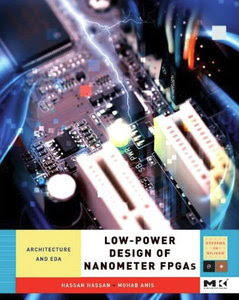Low-Power Design of Nanometer FPGAs: Architecture and EDA (Systems on Silicon) By Hassan Hassan, Mohab Anis
Publisher: Morgan Kaufmann 2009-10-12 | 352 Pages | ISBN: 0123744385 | PDF | 1.2 MB
Field Programmable Gate Arrays (FPGAs) have become very popular as embedded components in computing platforms. An FPGA is feasible, reprogrammable design approach that provides a rapid time to market alternative to application-specific integrated circuits (ASIC). Because FPGA implementations can be customized to suit any application, versatility leads to performance improvements, and allows the reuse of expensive silicon. Although high performance can be achieved in FPGAs, high levels of energy consumption poses a critical design challenge.
 This book will be a valuable reference for researchers and engineers interested in the practice of energy-efficient, FPGA design. Current status of power reduction techniques for FPGAs art are described and compared. These techniques are applied in the circuit, architecture, and levels of electronic design automation to describe both the sources of dynamic energy and leakage and that strategies for co design.
This book will be a valuable reference for researchers and engineers interested in the practice of energy-efficient, FPGA design. Current status of power reduction techniques for FPGAs art are described and compared. These techniques are applied in the circuit, architecture, and levels of electronic design automation to describe both the sources of dynamic energy and leakage and that strategies for co design.
Key Features:
Publisher: Morgan Kaufmann 2009-10-12 | 352 Pages | ISBN: 0123744385 | PDF | 1.2 MB
Field Programmable Gate Arrays (FPGAs) have become very popular as embedded components in computing platforms. An FPGA is feasible, reprogrammable design approach that provides a rapid time to market alternative to application-specific integrated circuits (ASIC). Because FPGA implementations can be customized to suit any application, versatility leads to performance improvements, and allows the reuse of expensive silicon. Although high performance can be achieved in FPGAs, high levels of energy consumption poses a critical design challenge.
 This book will be a valuable reference for researchers and engineers interested in the practice of energy-efficient, FPGA design. Current status of power reduction techniques for FPGAs art are described and compared. These techniques are applied in the circuit, architecture, and levels of electronic design automation to describe both the sources of dynamic energy and leakage and that strategies for co design.
This book will be a valuable reference for researchers and engineers interested in the practice of energy-efficient, FPGA design. Current status of power reduction techniques for FPGAs art are described and compared. These techniques are applied in the circuit, architecture, and levels of electronic design automation to describe both the sources of dynamic energy and leakage and that strategies for co design. Key Features:
- Design perspective on low-power FPGAs...low-power techniques presented at key FPGA design levels for circuits, architectures, and electronic design automation, form critical, "bridge" guidelines for co-design
- Low-leakage design in FPGAs. comprehensive review of leakage-tolerant techniques empowers designers to minimize power dissipation
- FPGA power estimation techniques. provides valuable tools for estimating power efficiency/savings of current, low-power FPGA design techniques



